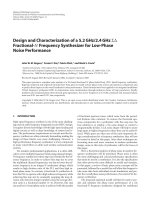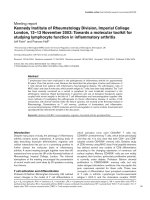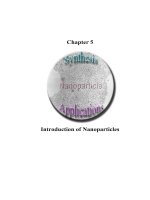Synthesis and characterization of group 11, 12 and 13 metal selenocarboxylates potential single molecular precursors for metal selenide nanocrystals 1
Bạn đang xem bản rút gọn của tài liệu. Xem và tải ngay bản đầy đủ của tài liệu tại đây (5.42 MB, 109 trang )
I
SYNTHESIS AND CHARACTERIZATION OF GROUP 11, 12
AND 13 METAL SELENOCARBOXYLATES: POTENTIAL
SINGLE MOLECULAR PRECURSORS FOR METAL SELENIDE
NANOCRYSTALS
NG MENG TACK
(B. Sc (Hons) NUS)
A THESIS SUBMITTED
FOR THE DEGREE OF DOCTOR OF PHILOSOPHY
DEPARTMENT OF CHEMISTRY
NATIONAL UNIVERSITY OF SINGAPORE
2006
II
Declaration
This work described in this thesis was carried at the Department of Chemistry,
National University of Singapore from 21
st
July 2002 to 21
st
July 2006 under the
supervision of Associate Professor Jagadese J. Vittal.
All the work described herein is my own, unless stated to the contrary, and it has
not been submitted previously for a degree at this or any other university.
Ng Meng Tack
November 2006
III
ACKNOWLEDGEMENTS
I would like to express my deepest gratitude to my supervisor, Associate
Professor Jagadese J. Vittal, for his moral and intellectual support during the course of
this project. With his guidance, I have really learned a lot from the enlightening
discussions during the training period. I would like to thank Dr. Chris Boothroyd from
Institite of Materials Research and Engineering (IMRE) for his valuable discussion on
the phase properties of Ag
2
Se and AgInSe
2
NPs.
Here, I would like to give special mention to my colleagues for their effort in
setting up a comfortable and causative working space in the lab for me.
To my friends Sin Yee, Li Hui, Doris, Tze Wee, Wee Leng and Danny:
Sincere thanks for their willingness to share with me. Truly, I am also indebted to my
beloved parents for their invaluable moral support and patient confidence in me.
I greatly appreciate the scholarship from the National University of Singapore
during my studies.
Last but no least, I would like to extend my appreciation to staff from the TG
lab, NMR lab, Microanalytical, TEM and IR lab. Your help has been invaluable.
I
Table of Contents
Acknowledgements
Table of Contents I
Abbreviations and Symbols VIII
Summary XI
List of Compounds Synthesized XIV
List of Figures XVIII
List of Tables and Schemes XXIII
List of Publications XXV
Chapter 1. Introduction to the Chemistry of Monochalcogenocarboxylate
1.1 General Introduction 1
1.2 Group 11 Metal Thio- and Selenocarboxylates 3
1.2.1 Copper Thio- and Selenocarboxylates 3
1.2.2 Silver Thiocarboxylates 5
1.2.3 Dppm Compounds of Copper and Silver
Thiocarboxylates
6
1.2.4 Homoleptic Copper and Silver Thiocarboxylates 7
1.3 Group 12 Metal Thio- and Selenocarboxylates 7
1.3.1 Neutral Group 12 Metal Thio- and Selenocarboxylates
Containing N-donor Ligands
11
1.4 Other Metal Thiocarboxylates 12
1.4.1 Group 13 Metalloligands Anion, [M(SC{O}Ph)
4
]
–
(M =
Ga
3+
, In
3+
)
12
II
1.4.2 Heterobimetallic Metal Thiocarboxylates 13
1.5 Single-Source Precursors for Metal Sulfides and Selenides 14
1.5.1 Thin Films 16
1.5.1.1 (Et
3
NH)[In(SC{O}Ph)
4
]·H
2
O, a Precursor for
CuInS
2
Thin Film
16
1.5.2 Nanoparticles 17
1.5.2.1 Cu
2-x
Se and Ag
2
S NPs 17
1.5.2.2 PbS and CdS NPs 18
1.5.2.3 AgInS
2
NPs 20
1.6 Aim and Scope of Part I of This Thesis 21
Chapter 2. Synthesis, Structure and Solution NMR Properties of
(Ph
4
P)[M(SeC{O}Tol)
3
], M = Zn, Cd and Hg
2.1 Introduction 22
2.2 Results and Discussion 23
2.2.1 Metal NMR Spectra 23
2.2.2 ESI-MS Studies 27
2.2.3 Structures of [M(SeC{O}Tol)
3
]
–
(M = Zn – Hg) 29
2.3 Summary 34
2.4 Experimental
34
2.4.1 NMR Studies 34
2.4.2 ESI-MS Studies 35
2.4.3 Syntheses 36
III
Chapter 3. Hetero-bimetallic and Polymeric Selenocarboxylates Derived from
[M(Se(C{O}Ph)
4
]
–
(M = Ga and In) as Molecular Precursors for Ternary
Selenides
3.1 Introduction 39
3.2 Results and Discussion 40
3.2.1 Structures of Hetero Bi-metallic and Polymeric
Selenocarboxylates
41
3.2.1.1 Structure of (Et
3
NH)[In(SeC{O}Ph)
4
]·H
2
O 43
3.2.1.2 Structures of [K(MeCN)
2
{M(SeC{O}Ph)
4
}] 44
3.2.1.3 Structures of
[(Ph
3
P)
2
M′In(SeC{O}Ph)
4
]·CH
2
Cl
2
46
3.2.2 Thermogravimetry and Pyrolysis Experiments 49
3.3 Summary 55
3.4 Experimental 55
Chapter 4. Synthesis, Structure and Thermal Properties of
[(Ph
3
P)
3
Ag
2
(SeC{O}Ph)
2
]
4.1 Introduction 61
4.2 Results and Discussion 62
4.2.1 Structure of [(Ph
3
P)
3
Ag
2
(SeC{O}Ph)
2
] and
[(Ph
3
P)Ag(SeC{O}Ph)]
4
63
4.2.2 Thermogravimetry and Pyrolysis Experiments 66
4.3 Summary 68
4.4 Experimental 68
References of Part I of the Thesis 70
IV
Chapter 5. Introduction to Nanoparticles
5.1 General Introduction 78
5.2 Applications of NPs 80
5.2.1 Luminescence 80
5.2.2 Biological Labeling 81
5.2.3 Light Emitting Diodes 83
5.2.4 Laser 83
5.2.5 Solar Cell 84
5.2.6 Sensing Applications 85
5.3 Syntheses of Nanomaterials 86
5.3.1 Coprecipitation Synthesis 87
5.3.2 Microemulsion Synthesis 88
5.3.3 Hydrothermal/Solvothermal Synthesis 89
5.3.4 Surfactant-controlled Growth in a Hot Organic Solvent(s)
91
5.3.4.1 Single Molecular Precursor Approach
95
5.4 Aim and Scope of Part II of This Thesis 97
Chapter 6. Shape and Size Control of Ag
2
Se NCs from Single Precursor
[(Ph
3
P)
3
Ag
2
(SeC{O}Ph)
2
]
6.1 Introduction 98
6.2 Results and Discussion 99
6.2.1 Formation of Ag
2
Se NCs from [(Ph
3
P)
3
Ag
2
(SeC{O}Ph)
2
] 99
6.2.2 Morphology and Characterization of the Ag
2
Se NCs 101
6.2.3 Growth Mechanism of Ag
2
Se NPs 105
6.3 Summary 108
V
6.4 Synthesis and Methodology 108
Chapter 7. Synthesis of Cu
2-x
Se NPs and Microflakes from
[(Ph
3
P)
3
Cu
2
(SeC{O}Ph)
2
]
7.1 Introduction 110
7.2 Formation and Characterization of Cu
2-x
Se NPs and Microflakes 111
7.2.1 HDA and TOP as Surfactants 111
7.2.2 DT and TOP as Surfactants 113
7.2.3 Ethylenediamine as Surfactants 116
7.3 Summary 118
7.4 Synthesis and Methodology
118
Chapter 8. Synthesis of ZnSe and CdSe NPs from Neutral Zn(II) and Cd(II)
Selenocarboxylates
8.1 Introduction 120
8.2 Results and Discussion 121
8.2.1 Optical Properties of ZnSe NPs 122
8.2.2 Optical Properties of CdSe NPs 125
8.2.3 Structural Characterization of ZnSe and CdSe NPs 129
8.3 Summary 133
Synthesis and Methodology 134
8.4.1 Synthesis of [Cd(SeC{O}Ph)
2
] and
[Zn(SeC{O}Tol)
2
]·(H
2
O)
134
8.4.2 Synthesis of ZnSe and CdSe NPs 135
8.4
VI
Chapter 9. One-Pot Synthesis of New Orthorhombic Phase AgInSe
2
NRs
9.1 Introduction 136
9.2 Structural Characterization of AgInSe
2
NPs 137
9.3 Crystal Structure Characterization of AgInSe
2
NRs 141
9.4 NLO Properties of AgInSe
2
NRs 146
9.5 Summary 147
9.6 Synthesis and Methodology 147
Chapter 10. Synthesis of CuInSe
2
NPs
10.1 Introduction 149
10.2 Results and Discussion 150
10.2.1 CuInSe
2
NPs Synthesized from OA and DT Solvents 150
10.2.2 CuInSe
2
NPs Synthesized from DT and TOPO Solvents 153
10.3 Summary 156
10.4 Synthesis and Methodology 157
References of Part II of the Thesis
158
Chapter 11. Summary, Highlight and Possible Extension for Future Work
11.1 Significant of Current Study 170
11.2 Suggestion for Future Work 174
Chapter 12. Experimental
12.1 General 177
12.1.1 Preparation of Na
2
Se and K
2
Se 178
12.2 Elemental Analysis
178
VII
12.3 Infrared Spectroscopy 179
12.4 NMR Spectroscopy 179
12.5 ESI-MS 179
12.6 TGA 179
12.7 UV-vis Spectroscopy 179
12.8 Photoluminescence Spectroscopy 179
12.9 X-ray Powder Diffraction 180
12.10 Single Crystal X-ray Diffraction 180
12.11 Scanning Electron Microscope 180
12.12 TEM 180
12.13 EDX 181
12.14 NLO Measurement
181
References 181
Appendix
182
VIII
Abbreviations
AACVD Aerosol Assisted Chemical Vapor Deposition
ALAD 5-Aminolevulinate Dehydratase
Bpy 4, 4,’-Bipyridyl
2, 2’-bipy 2, 2,’-Bipyridyl
Bu Butyl
CH
2
Cl
2
Dicholomethane
CVD Chemical Vapor Deposition
Cys Cysteine
Dppm Bis(diphenylphosphino) methane
DSC Differential Scanning Calorimetry
DT Dodecanethiol
EDX Energy Dispersive X-ray Spectroscopy
EtOH Ethanol
ESI-MS Electrospray Ionisation Mass Spectrometry
HDA Hexyldecylamine
FTIR Fourier Transform Infrared
HOMO Highest Occupied Molecular Orbital
HRTEM High Resolution Transmission Electronic Microscope
Iso-Bu Iso-butyl
IR Infra Red
JCPDS Joint Committee of Powder Diffraction Society
LED Light Emitting Diode
LUMO Lowest Unoccupied Molecular Orbital
Lut 3, 5-Dimethylpyridine
IX
Me Methyl
MeCN Acetonitrile
MeOH Methanol
NLO Non-Linear Optical
NMR Nuclear Magnetic Resonance
MOCVD Metal Organic Vapor Deposition
NC Nanocrystal
NP Nanoparticle
NR Nanorod
OA Oleylamine
PL Photoluminescence
Ph Phenyl
PPh
3
Triphenylphosphine
Pr Propane
QD Quantum Dot
RT Room Temperature
SAED Selective Area Electron Diffraction
SEM Scanning Electron Microscope
TOPO Tri-n-octylphosphine Oxide
TOP Tri-n-octylphosphine
TEM Transmission Electronic Microscope
TGA Thermogravimetric Analysis
TMEDA N, N, N, N’-Tetramethylethylenediamine
Tolyl 4-Methyl-Phenyl
Tol Methyl Benzene
X
UV-vis Ultra Violet-Visible
XPS X-Ray Photoelectron Spectroscopy
XRPD X-Ray Powder Diffraction
XI
Summary
This PhD thesis describes the synthesis and characterization of a few group
11, 12 and 13 metal selenocarboxylate complexes. The objective of the study is to
explore the chemistry of these compounds and the suitability of these as single-source
precursors to metal selenide bulk materials and NPs. This thesis comprises two parts.
In the first part (chapter 1 to 3) our discussion is focused on the syntheses and
characterization, structures and thermal properties of metal selenocarboxylate
complexes. In the second part of this thesis, (chapter 4 to 8) we have discussed the
syntheses of the various metal selenide NPs obtained from the metal
selenocarboxylate single-source precursors.
The chemistry of metal thiocarboxylates and the usage of these complexes in
preparing metal sulfide bulks, thin films and NPs have been reviewed in chapter 1. In
the following chapter, the preparation and characterization of Zn, Cd and Hg metal
selenocarboxylates anion, [M(SeC{O}Tol)
3
]
-
have been discussed. The single-crystal
X-ray diffraction techniques confirmed the presence of discrete
tetraphenylphosphonium cations and anions in the crystal lattice. Trigonal planar
MSe
3
kernel is observed in these anionic metal selenocarboxylates. NMR spectra
(
113
Cd,
199
Hg and
77
Se, as appropriate) and ESI-MS analysis of these metal
selenocarboxylates in solution have shown that the complexes
[M(SeC{O}Tol)
n
(SC{O}Ph)
3−n
]
−
(n = 3 – 0) persist in solution.
In chapter 3, synthesis and characterization of (Et
3
NH)[In(SeC{O}Ph)
4
]·H
2
O
along with hetero-bimetallic and polymeric metal selnocarboxylates, namely
[NaGa(SeC{O}Ph)
4
], [K(MeCN)
2
{Ga(SeC{O}Ph)
4
}], [NaIn(SeC{O}Ph)
4
],
[K(MeCN)
2
{In(SeC{O}Ph)
4
}], [(Ph
3
P)
2
CuIn(SeC{O}Ph)
4
]·CH
2
Cl
2
and
[(Ph
3
P)
2
AgIn(SeC{O}Ph)
4
]·CH
2
Cl
2
have been discussed. The thermal decomposition
XII
of these compounds led to the formation of the corresponding metal selenides as
confirmed by TGA and in some cases by powder X-ray diffraction studies.
In chapter 4, the synthesis, characterization and thermal decomposition of
[(Ph
3
P)
3
Ag
2
(SeC{O}Ph)
2
] and [(Ph
3
P)Ag(SeC{O}Ph)]
4
are discussed. The former
compound has been found to be a suitable single-source precursor for Ag
2
Se.
In Chapter 6, the synthesis of Ag
2
Se NPs from [(Ph
3
P)
2
Ag
2
(SeC{O}Ph)
2
] has
been discussed. The Ag
2
Se NCs are highly monodispersed and they formed
interesting morphology e. g., faceted NCs and nanocubes. The shape and size of these
NCs are tunable by changing the reaction conditions. The growth mechanism of these
NCs has been proposed.
In the following chapter, a similar precursor, [(Ph
3
P)
2
Cu
2
(SeC{O}Ph)
2
] has
been employed to prepare the Cu
2-x
Se Nps. Both HDA and DT surfactants induced an
anisotropic growth on Cu
2-x
Se NPs. The growth mechanism of Cu
2-x
Se Nps has been
found to be different from Ag
2
Se NPs although similar molecular precursor was used
in the nanosynthesis.
In chapter 8, synthesis and characterization of ZnSe and CdSe Nps have been
presented. The obtained ZnSe NCs show poor luminescence property which could be
due to the deep trap emission. In contrast, strong quantum confinement effect and
luminescence property has been observed in the CdSe NCs. The size of the prepared
NPs has been found to be close to monodisperse.
In chapter 9, the synthesis of a new phase AgInSe
2
nanorods has been
discussed. The synthesized AgInSe
2
nanorods are close to monodispersed and the
morphology can be tuned by changing the experimental conditions. TEM, XRPD,
XPS, EDX have been used to characterize this new phase materials.
XIII
In chapter 10, the synthesis of CuInSe
2
NCs will be discussed. Pure tetragonal
CuInSe
2
NPs were synthesized from [(Ph
3
P)
2
CuIn(SeC{O}Ph)
4
] in TOPO/DT
solvents. The CuInSe
2
NPs strongly aggregate on the copper grid. An unknown
compound was obtained together with tetragonal CuInSe
2
NP when the reactions were
conducted in OA/DT solvents.
Finally the salient features of this investigations have been summarized along
with future direction of work in this area.
XIV
List of Compounds
No. Compound Structure
1
(Ph
4
P)[Zn(SeC{O}Tol)
3
]
Zn
Se
Se
Se
O
O
O
2
(Ph
4
P)[Cd(SeC{O}Tol)
3
]
Cd
Se
Se
Se
O
O
O
3
(Ph
4
P)[Hg(SeC{O}Tol)
3
]
Hg
Se
Se
Se
O
O
O
XV
4
(Et
3
NH)[In(SeC{O}Ph)
4
]·H
2
O
In
Se
Se
Se
Se
O
O
O
O
5
[NaGa(SeC{O}Ph)
4
]
6
[K(MeCN)
2
Ga(SeC{O}Ph)
4
]
7
[NaIn(SeC{O}Ph)
4
]
8
[K(MeCN)
2
In(SeC{O}Ph)
4
]
XVI
9
[(Ph
3
P)
2
CuIn(SeC{O}Ph)
4
]·CH
2
Cl
2
Cu
Se
Se
In
O
Se
Se
O
PPh
3
PPh
3
O
O
10
[(Ph
3
P)
2
AgIn(SeC{O}Ph)
4
]·CH
2
Cl
2
Ag
Se
Se
In
O
Se
Se
O
PPh
3
PPh
3
O
O
11
[(Ph
3
P)
3
Ag
2
(SeC{O}Ph)
2
]
Ag
Se
Se
Ag
O
PPh
3
PPh
3
PPh
3
O
XVII
11b
[(Ph
3
P)Ag(SeC{O}Ph)]
4
·CH
2
Cl
2
Se
Ag
Se
Ag
Se
Ag
Se
Ag
PPh
3
PPh
3
PPh
3
Ph
3
P
O
O
O
O
XVIII
List of Figures
Chapter 1
Figure 1.1
Ball and stick diagram of [Cu
3
(µ-dppm)
3
(µ
3
-SC{O}Ph-S)(µ
3
-
SC{O}Ph-S,O)]
2+
and [Ag
3
(dppm)
3
(µ-SC{O}Ph-S)
2
]
2+
cations··
6
Figure 1.2
The structures of (Ph
4
P)[M(SC{O}Me)
2
] and [(Et
3
NH)
2
Ag
2
(SC{O}Ph)
4
]··········································································
7
Figure 1.3
Ball and stick diagram of [Ni(SC{O}Ph)
3
]
–
anion unit················
8
Figure 1.4
Views of the three crystallographically different anions in
[Cd(SC{O}Ph)
3
]
–
, showing the numbering scheme used: (a)
anion A; (b) anion B; (c) anion C. Atoms are shown as 50%
probability thermal ellipsoids. Hydrogen atoms have been
omitted for clarity·········································································
9
Figure 1.5
Ball & stick diagram of [Zn(SC{O}Me)
3
(H
2
O)]
–
as synthetic
mimics of ALAD··········································································
10
Figure 1.6
Repeating unit of the 1D polymer [Cd
2
(SC{O}Ph)
4
(µ-Bpy)]
n
····
11
Figure 1.7
A ball and stick diagram of [KIn(SC{O}Ph)
4
(MeCN)
2
] and a
segment of its polymeric structure···············································
12
Figure 1.8
A ball and stick diagrams of
[M(H
2
O)
x
{In(SC{O}Ph)
4
}
2
]·(H
2
O)
y
(M = Ca and Mg; x = 0 –
2; y = 0 – 2). Lattice water molecules were removed for clarity·
13
Figure 1.9
Ball & stick diagrams of I-9 and I-11a········································ 14
Figure 1.10
Faceted and cubic shaped Ag
2
S NPs obtained from thermolysis
of [Ag(SC{O}Ph)]········································································
18
Figure 1.11
TEM images of PbS a) dendrites and b) NRs······························ 19
Figure 1.12
a) Low resolution and b) high resolution TEM images of the
synthesized AgInS
2
NPs·······························································
21
Chapter 2
Figure 2.1
ESI-MS spectra of [M(SeC{O}Tol)
n
(SC{O}Ph)
3–n
]
–
, n = 0, 1, 2
and 3; M = Zn (A), Cd (B) and Hg(C)·········································
28
Figure 2.2
Diagram showing the numbering scheme and 50% probability
thermal ellipsoids of the [Zn(SeC{O}Tol)
3
]
–
anion in 1.
Hydrogen atoms are omitted for clarity·······································
30
Figure 2.3
Diagram showing the numbering scheme and 50% probability
thermal ellipsoids of the [Hg(SeC{O}Tol)
3
]
–
anion in 3.
Hydrogen atoms are omitted for clarity·······································
30
Chapter 3
Figure 3.1
A ball and stick diagram of 4······················································· 43
Figure 3.2
An perspective view showing the coordination environment
around the metal centers in compounds 6 and 8··························
45
Figure 3.3
Segments of the one-dimensional coordination of compounds 6
and 8. The hydrogen atoms and phenyl rings are omitted for
clarity····························································································
45
Figure 3.4
A perspective view of 9 and 10. Hydrogen atoms are removed
for clarity······················································································
47
XIX
Figure 3.5
XRPD patterns of 5 and 7·····························································
48
Figure 3.6
Overlay of thermogravimetric curves of 4 – 10··························· 49
Figure 3.7
XRPD patterns of the pyrolyzed products of 6 and 8 along with
the reported XRPD pattern of KInSe
2
··········································
52
Figure 3.8
XRPD patterns of the pyrolyzed product of 6 along with the
reported XRPD pattern of KGaTe
2
··············································
52
Figure 3.9
XRPD patterns of the pyrolyzed product of 5 and 7 along with
the reported XRPD pattern of Na
2
Ga
2
Se
3
····································
53
Figure 3.10
XRPD patterns of the decomposed products of compounds 4, 9
and 10···························································································
54
Chapter 4
Figure 4.1
Ball and stick diagram of 11. Hydrogen atoms and solvent
molecule were removed for clarity···············································
64
Figure 4.2
A view of compound 11a. Hydrogen atoms, phenyl groups on
the Ph
3
P and solvent molecule were deleted for clarity···············
66
Figure 4.3
Thermogravimetric curves of 11·················································· 67
Figure 4.4
XRPD spectrum of the decomposed products of 11, 12 and 13···
67
Chapter 5
Figure 5.1
Schematic illustration of the density of states, along with the
changes in the band gap, in semiconductor clusters·····················
79
Figure 5.2
Idealized density of states for one band of a semiconductor
structure of 3 – 0 dimensions·······················································
80
Figure 5.3
Room-temperature emission (left) and absorption (right)
spectra taken from difference sizes CdSe NPs·····························
81
Figure 5.4
True color image of CdSe NPs illuminated with UV light.
(Image was taken from -
oldenburg.de/pv/nano/index.html)···············································
83
Figure 5.5
Polarized emission measurements for lasing in (a) NCs and (b)
NRs·······························································································
84
Figure 5.6
(A) Schematic diagram of a platinum mesowire array-based
hydrogen sensor or switch. (B) SEM image [400 mm(h) by 600
mm (w)] of the active area of a platinum mesowire array-based
hydrogen sensor············································································
86
Figure 5.7
TEM images of poly(N-vinyl-2-pyrrolidone) capped (a) Au and
(b) Pt NPs·····················································································
88
Figure 5.8
TEM image of rutile (rodlike) and anatase (granulous) TiO
2
······ 90
Figure 5.9
A near monolayer of 5 nm CdSe NPs showing short-range
hexagonal close packing·······························································
92
Figure 5.10
HRTEM image of CdSe/ZnS-core/shell NPs······························· 93
Figure 5.11
TEMs of CdSe NPs from the single-injection experiments. The
surfactant ratio was increased from (a) 8 to (b) 20 to (c) 60%
HPA in TOPO. For the injection volume experiments (d-f),
20% HPA in TOPO was used, as it was found to provide
optimal rod growth conditions·····················································
94
Figure 5.12
TEM images of various sizes CdSe NPs······································ 95
XX
Figure 5.13
TEM images of various shapes CdS (a – b), MnS (c – d) and
PbS (e – f) NPs·············································································
96
Chapter 6
Figure 6.1
TEM images of Ag
2
Se nanocubes produced at 125 °C after 60
min with surfactant-to-precursor ratios of a) 25 and b) 50
respectively; c) HRTEM image showing the lattice fringes from
a single nanocube·········································································
101
Figure 6.2
TEM image of silver selenide nanocubes synthesized under
same conditions as in Fig.1a and 1b, except the growth time
was shortened from 60 min to 15 min··········································
102
Figure 6.3
TEM images of Ag
2
Se NCs prepared at 165 °C for 15 min with
surfactant-to-precursor ratio of, a) 25 and b) 50··························
103
Figure 6.4
TEM images of faceted Ag
2
Se NCs prepared at 180 °C for 5
min with surfactant-to-precursor ratio of, a) 25 and b) 50···········
103
Figure 6.5
X-ray powder diffraction patterns obtained at room temperature
from Ag
2
Se NCs synthesized at different temperatures···············
104
Figure 6.6
DSC curve of the prepared Ag
2
Se NCs········································ 105
Figure 6.7
Shapes and sizes of Ag
2
Se NCs produced under different
conditions after 15 min of heating················································
106
Figure 6.8
TEM images of silver selenide NPs synthesized using an
amine-to-precursor ratio of 50 after 15 min of heating at (a) 95
°C, (b) 125 °C and (c) 145 °C······················································
107
Figure 6.9
(a) SEM image of Ag
2
Se obtained from the pyrolysis of
[(Ph
3
P)
3
Ag
2
(SeC{O}Ph)
2
]. (b) An enlarged portion of the cube-
shaped Ag
2
Se crystal is shown at the right hand lower corner····
107
Chapter 7
Figure 7.1
(a) Low resolution TEM image of Cu
2-x
Se NCs. (b) Zoom in
TEM image of twinned Cu
2-x
Se NCs. (c) HRTEM image of a
twinned crystal. (d) SAED spectrum of Cu
2-x
Se NPs··················
112
Figure 7.2
TEM images of Cu
2-x
Se NPs isolated after 10 min of heating at
220 ˚C with different DT to precursor molar ratio, (a) 45, (b) 90
and (c) 180····················································································
114
Figure 7.3
IR spectrum of Cu
2-x
Se NP···························································
115
Figure 7.4
TEM images of Cu
2-x
Se NPs isolated after 10 min of heating at
(a) 220 ˚C; (b) 250 ˚C and (c) 280 ˚C with surfactant-to-
precursor ratio at 90······································································
116
Figure 7.5
SEM images of Cu
2-x
Se macro flasks obtained from ethylene
diamine·························································································
117
Figure 7.6
XRPD patterns of Cu
2-x
Se obtained from (a) ethylenediamine;
(b) HDA and (c) DT·····································································
117
Chapter 8
Figure 8.1
UV-absorption spectra of ZnSe NPs taken at different time
intervals (The absorption spectra at 15 and 30 min are identical)
123
XXI
Figure 8.2
Photoluminescence spectrum of ZnSe NPs at different time
intervals························································································
124
Figure 8.3a
UV-absorption spectra of ZnSe NPs isolated at various
temperatures after 5 min of heating··············································
125
Figure 8.3b
UV-absorption spectra of ZnSe NPs isolated at various HDA
concentration after 5 min of heating·············································
125
Figure 8.4
Optical absorption spectra of CdSe NPs synthesized
with/without HPA·········································································
126
Figure 8.5
Uv-absorption spectra of CdSe NPs synthesized at different
HPA concentration·······································································
127
Figure 8.6a
UV-absorption spectra of CdSe NPs isolated at different
temperature after 5 min of heating···············································
127
Figure 8.6b
UV-absorption spectra of CdSe NPs isolated at different TOPO
concentration after 5 min of heating·············································
127
Figure 8.7
Optical spectra of CdSe NPs taken at different time intervals
(250 ºC; 2.6 g of TOPO; 44.7 mg of HPA)··································
128
Figure 8.8
(a) Optical absorption (blue) and (b) photoluminescence (red)
spectra of CdSe NPs. (t = 5 min)··················································
129
Figure 8.9
XRPD patterns of ZnSe and CdSe NPs········································ 130
Figure 8.10
SAED of (a) ZnSe and (b) CdSe·················································· 130
Figure 8.11
(a) Low resolution and (b) high resolution TEM images of
ZnSe NPs. (c) The size distribution of the ZnSe NPs··················
131
Figure 8.12
(a) Low resolution and (b) high resolution TEM images of
CdSe NPs. (c) The size distribution of the CdSe NPs··················
132
Figure 8.13
EDX of (a) ZnSe, (b) CdSe NPs···················································
132
Figure 8.14
IR spectra of TOPO, ZnSe and CdSe NPs··································· 133
Chapter 9
Figure 9.1
Low-magnification TEM images of (a) AgInSe
2
NRs, (b)
AgInSe
2
NCs. (c) HRTEM micrograph showing the crystal
lattice of an individual NR. (d) SAED pattern of AgInSe
2
NR····
137
Figure 9.2
(A) TEM images of AgInSe
2
obtained from pure oleylamine
and (B) XRPD pattern of the corresponding AgInSe
2
. Peaks
labeled in * correspond to the tetragonal phase AgInSe
2
·············
138
Figure 9.3
IR spectra of AgInSe
2
NRs, pure DT, OA and the precursor·······
139
Figure 9.4
EDX and the elemental composition analysis of the synthesized
AgInSe
2
NRs. The copper and carbon signals are from the
TEM copper grid. The Si signal is from the detector. The
oxygen signal is from the oxidized AgInSe
2
································
140
Figure 9.5
TEM images of AgInSe
2
NRs obtained from (A) mixture of OA
and DT at 185 °C after 1.5 hours of heating. (B) Mixture of
HDA and DT. (The mole ratio of each capping agent to the
precursor is fixed at 100)······························································
140
Figure 9.6
(A) XRPD pattern of AgInSe
2
NRs obtained from OA and DT
at 185 ˚C. (B) Bulk AgInSe
2
obtained from pyrolysis of the
precursor·······················································································
141
Figure 9.7
XPS spectra of the as-prepared AgInSe
2
NRs······························ 143
XXII
Figure 9.8
(A) XRPD peak positions for orthorhombic AgInS
2
. X-ray
spectra from AgInSe
2
NRs prepared at the following DT
concentrations. surfactant-to-precursor ratio = 100 (B); 80 (C);
60 (D); 40 (E); 20 (F)···································································
144
Figure 9.9
XRPD patterns of AgInSe
2
NCs obtained using various
surfactants. (T = tetragonal; O = Orthorhombic; * = impurities)
145
Figure 9.10
XRPD patterns of AgInSe
2
NPs prepared at the various
temperatures·················································································
145
Figure 9.11
(a) Open- and (b) closed-aperture Z-scans of 1-mm-thick
solution of the AgInSe
2
NRs measured with 200-fs laser pulses
of 780-nm wavelength. The laser irradiance used is in the range
from 5 GW/cm
2
to 47 GW/cm
2
. The solid lines are the best-fit
curves calculated by using the Z-scan theory. The closed-
aperture Z-scan curves in (b) are shifted vertically for clear
presentation. (c) Irradiance dependence of the nonlinear
absorption coefficient (
α
2
NRs
) and nonlinear refractive index
(n
2
NRs
) for the AgInSe
2
NR solution·············································
146
Chapter 10
Figure 10.1
XRPD patterns of the black precipitate obtained from the
OA/DT solvents. Peaks labeled with “T” is correspond to
tetragonal CuInSe
2
········································································
151
Figure 10.2
TEM images (a & c) of the NPs that obtained from one-pot
reaction at 185 ºC with [surfactant]/[precursor] = 100, together
with the corresponding SAED images (b & d)·····························
152
Figure 10.3
XRPD patterns of NPs obtained from OA/DT (surfactants-to-
precursor ratio = 100) solvents at 250 ˚C after (a) 5 and (b) 15
hours heating. (Peaks labeled with “T” are correspond to
tetragonal phase CuInSe
2
)····························································
153
Figure 10.4
XRPD patterns of CuInSe
2
NP synthesized at 230 ˚C with
molar ratio of 1:50:50 (precursor:TOPO:DT) after 2 hours of
heating··························································································
154
Figure 10.5
(a) Low resolution and (b) & (c) high resolution TEM images
and (d) SAED spectrum of CuInSe
2
NPs obtained from
TOPO/DT solvents at 230 ˚C·······················································
155
Figure 10.6
XRPD patterns of CuInSe
2
NPs synthesized at various
temperature. Calculated sizes for CuInSe
2
NPs based on their
XRPD spectra are 8.0 nm (125 °C), 25.5 nm (180 °C), 12.5 nm
(200 °C) and 14.5 (230 °C)··························································
156









